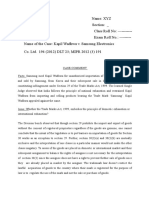Summarized
Summarized
Uploaded by
Justine FloresOriginal Description:
Copyright
Available Formats
Share this document
Did you find this document useful?
Is this content inappropriate?
Report this DocumentCopyright:
Available Formats
Summarized
Summarized
Uploaded by
Justine FloresCopyright:
Available Formats
Summarized
Hydroelectric power plant, also called hydropower, electricity produced from
generators driven by turbines that convert the potential energy of falling or fast-
flowing water into mechanical energy.
In the generation of hydroelectric power, water is collected or stored at a
higher elevation and led downward through large pipes or tunnels (penstocks) to a
lower elevation; the difference in these two elevations is known as the head.
In some dams, the powerhouse is constructed on one flank of the dam, part of
the dam being used as a spillway over which excess water is discharged in times of
flood.
A nuclear power plant (sometimes abbreviated as NPP) is a thermal power
station in which the heat source is a nuclear reactor.
Nuclear plants are very often used for base load since their operations,
maintenance, and fuel costs are at the lower end of the spectrum of costs.
Nuclear power plants have a carbon footprint comparable to that of renewable
energy such as solar farms and wind farms, and much lower than fossil fuels such as
natural gas and brown coal.
A coal-fired power station or coal power plant is a thermal power station
which burns coal to generate electricity.
Thus chemical energy stored in coal is converted successively into thermal
energy, mechanical energy and, finally, electrical energy.
Coal-fired power stations emit over 10 Gt of carbon dioxide each year, about
one fifth of world greenhouse gas emissions, so are the single largest cause of climate
change.
Some remain profitable because costs to other people due to the health and
environmental impact of the coal industry are not priced into the cost of generation,
but there is the risk newer plants may become stranded assets.
Geothermal energy is heat within the earth. The word geothermal comes from
the Greek words geo (earth) and therme (heat). Geothermal energy is a renewable
energy source because heat is continuously produced inside the earth. People use
geothermal heat for bathing, to heat buildings, and to generate electricity.
Geothermal power plants require high-temperature (300°F to 700°F)
hydrothermal resources that come from either dry steam wells or from hot water
wells.
Geothermal energy, one of the most promising among renewable energy
sources, has proven to be reliable, clean and safe, and therefore, its use for power
production, and heating and cooling is increasing.
You might also like
- Teknik Dabel Maru (Double Marubozu Technique) .Ms - enDocument25 pagesTeknik Dabel Maru (Double Marubozu Technique) .Ms - enDue Torri94% (16)
- Geothermal EnergyDocument10 pagesGeothermal EnergyashapwincygmailcomNo ratings yet
- Programing ASiMon V3 G2 enDocument413 pagesPrograming ASiMon V3 G2 enAssis NunesNo ratings yet
- Types of Power PlantsDocument8 pagesTypes of Power PlantsAdhanom G.No ratings yet
- GEOTHERMAL POWER PLANT. CastilloxbachillerDocument33 pagesGEOTHERMAL POWER PLANT. CastilloxbachillerCastillo MiraNo ratings yet
- Project Proposal Geothermal Power Plant - GROUP 6Document8 pagesProject Proposal Geothermal Power Plant - GROUP 6Emogen Kate CastilloNo ratings yet
- PhysciDocument27 pagesPhyscisophia lizarondoNo ratings yet
- Geothermal Energy Report Group 4Document40 pagesGeothermal Energy Report Group 4Jhonloyd Rosete LittauaNo ratings yet
- NCES U4 & U5 NotesDocument25 pagesNCES U4 & U5 Notes20ag1a6716No ratings yet
- Sources of Energy Notes Specially HandwrittenDocument9 pagesSources of Energy Notes Specially Handwrittenjeevan krishnaNo ratings yet
- CH 10 Geothermal EnergyDocument5 pagesCH 10 Geothermal EnergyscharichNo ratings yet
- ELS GeothermalDocument36 pagesELS GeothermalStephano John A. BalingaoNo ratings yet
- Origin and Distribution of Geothermal EnergyDocument6 pagesOrigin and Distribution of Geothermal EnergyEklavya TripathiNo ratings yet
- Geothermal PowerDocument3 pagesGeothermal Poweralisalihosman12No ratings yet
- 4.4 Energy and Its UsesDocument30 pages4.4 Energy and Its UseseltytanNo ratings yet
- Pros of GeothermalDocument4 pagesPros of Geothermaldeviana restiNo ratings yet
- Geo Themal Energy (News Letter)Document1 pageGeo Themal Energy (News Letter)Bhashantha Sudesh MunasingheNo ratings yet
- Renewable Energy Technologies - Assignment TwoDocument28 pagesRenewable Energy Technologies - Assignment Twojackson mathiasNo ratings yet
- Environmental ConcersDocument4 pagesEnvironmental Concersamitgupta_foryouNo ratings yet
- Geothermal Energy: M - I K R o M A P I P I 0 6 1 7 4 0 4 1 1 8 2 4Document5 pagesGeothermal Energy: M - I K R o M A P I P I 0 6 1 7 4 0 4 1 1 8 2 4veti veraNo ratings yet
- ProjectDocument4 pagesProjecttejasg0506No ratings yet
- Ex 1&2 UmaDocument7 pagesEx 1&2 UmaBhuvaneshwaran MSNo ratings yet
- 01 Mining HeatDocument0 pages01 Mining HeatGian Angga PratamaNo ratings yet
- Renewable EnergyDocument13 pagesRenewable EnergyJawad SandhuNo ratings yet
- Benefits of Having Geothermal Power PlantDocument1 pageBenefits of Having Geothermal Power PlantRon Harold EsternonNo ratings yet
- Geothermal EnergyDocument22 pagesGeothermal EnergyPavankumar PavankumarpvNo ratings yet
- 1.9 Geothermal Power: Mal Reservoirs Are Formed. The Thermal Energy of These Reservoirs Can Be TakenDocument2 pages1.9 Geothermal Power: Mal Reservoirs Are Formed. The Thermal Energy of These Reservoirs Can Be TakenKyaw Myo LinNo ratings yet
- Power From RenewablesDocument18 pagesPower From Renewablessor_68mNo ratings yet
- Mani Report 1Document53 pagesMani Report 1Mani MukatiNo ratings yet
- A Must Read PaperDocument8 pagesA Must Read PaperCarmel UyumbuNo ratings yet
- Nuclear Power PlantDocument11 pagesNuclear Power PlantVikas KatiyarNo ratings yet
- Geothermal+biofuel 2 REDocument4 pagesGeothermal+biofuel 2 REخلدون مهند الحديثيNo ratings yet
- Geothermal Power PointDocument69 pagesGeothermal Power PointArielle Jean BarcenasNo ratings yet
- Some Energy Creating Techniques and How Perpetual Motion Revolutionizes The GameDocument18 pagesSome Energy Creating Techniques and How Perpetual Motion Revolutionizes The GameAditya SharmaNo ratings yet
- Types of Renewable Energy: What Is Renewable Energy and How Does It Work?Document3 pagesTypes of Renewable Energy: What Is Renewable Energy and How Does It Work?JJNo ratings yet
- EnergyDocument45 pagesEnergyAlizeh ShoaibNo ratings yet
- Geothermal Powerplant: Activity No. 7Document13 pagesGeothermal Powerplant: Activity No. 7Neil BrazaNo ratings yet
- López Pablo López Professors: María Angélica Kaulen, Consuelo Gajardo English Language III 25 May 2011 Energy Chart 1Document4 pagesLópez Pablo López Professors: María Angélica Kaulen, Consuelo Gajardo English Language III 25 May 2011 Energy Chart 1Pablo Andrés López LópezNo ratings yet
- Sources of EnergyDocument22 pagesSources of EnergyVishisht KhilariwalNo ratings yet
- Projet AnglaisDocument3 pagesProjet AnglaisIlyes NedjaiNo ratings yet
- Ep AssignmentDocument11 pagesEp AssignmentAshithosh NairNo ratings yet
- Thermal Power Generation Full Seminar Report 74537Document23 pagesThermal Power Generation Full Seminar Report 74537Umang Vyas88% (8)
- Energy Law & Policy: Section A Short Notes: 1. Geothermal Energy: Geothermal Energy IsDocument18 pagesEnergy Law & Policy: Section A Short Notes: 1. Geothermal Energy: Geothermal Energy Isdebjyoti_das_6No ratings yet
- P3 Energy ResourcesDocument1 pageP3 Energy ResourcesArun DonteNo ratings yet
- Steam Power Plants Are Widely Utilized Throughout The World For ElectricityDocument27 pagesSteam Power Plants Are Widely Utilized Throughout The World For ElectricityCecille ClaridadNo ratings yet
- GeothermalDocument16 pagesGeothermalBlythe W. EmpizoNo ratings yet
- E Content Electrical Power IDocument185 pagesE Content Electrical Power Igkulkarni298No ratings yet
- Introduction To Power GenerationDocument4 pagesIntroduction To Power GenerationKirui CharlesNo ratings yet
- Introduction To HydropwerDocument8 pagesIntroduction To HydropwerArus EdoNo ratings yet
- RE-Unit 5Document12 pagesRE-Unit 5PALAK GARGNo ratings yet
- Renewable Resources: Natural Gas Alternative EnergyDocument3 pagesRenewable Resources: Natural Gas Alternative EnergyAKHILNo ratings yet
- GeothermalDocument13 pagesGeothermalKorsa KorsaNo ratings yet
- 8 EnergyDocument45 pages8 EnergysaheelwazirNo ratings yet
- Oee351 Unit 1 III CseDocument20 pagesOee351 Unit 1 III Cseanusrikanimurugan100% (3)
- Renewable EnergyDocument5 pagesRenewable EnergyWalid MaheriNo ratings yet
- Geothermal Energy Facts (TGS)Document10 pagesGeothermal Energy Facts (TGS)Putri_Afifah_4338No ratings yet
- Hydro Power Plants and Thermal Power PlantsDocument26 pagesHydro Power Plants and Thermal Power PlantsAbhishek KaleNo ratings yet
- CH 6 Energy Work PowerDocument47 pagesCH 6 Energy Work PowerShahdil WaheedNo ratings yet
- Renewable Energy Is Energy Which Comes From Natural Resources Such As Sunlight, Wind, Rain, Tides, and Geothermal Heat, Which Are Renewable (Naturally Replenished)Document67 pagesRenewable Energy Is Energy Which Comes From Natural Resources Such As Sunlight, Wind, Rain, Tides, and Geothermal Heat, Which Are Renewable (Naturally Replenished)Turab Ali BhattiNo ratings yet
- Types of Power Plants - 2018 PDFDocument71 pagesTypes of Power Plants - 2018 PDFJeff Justine GeragaNo ratings yet
- Thermodynamic analysis of geothermal heat pumps for civil air-conditioningFrom EverandThermodynamic analysis of geothermal heat pumps for civil air-conditioningRating: 5 out of 5 stars5/5 (2)
- Affidavit of Non-Compliance With AgreementDocument3 pagesAffidavit of Non-Compliance With AgreementAz-Zubayr Salisa0% (1)
- Shortcut Keys of Ms Office: Assignment # 03Document7 pagesShortcut Keys of Ms Office: Assignment # 0392azeem161100% (1)
- 48 Common Interview Questions With AnswersDocument8 pages48 Common Interview Questions With AnswersRosy BandariNo ratings yet
- Spe 14100 PaDocument10 pagesSpe 14100 PaSaurav SenguptaNo ratings yet
- Ad Form FPSCDocument2 pagesAd Form FPSCHaider ShaikhNo ratings yet
- Aranda Vs CADocument3 pagesAranda Vs CAdayneblazeNo ratings yet
- Tips To Start Up A BusinessDocument3 pagesTips To Start Up A BusinessJulhayda FernandoNo ratings yet
- Mirror Ray Diagrams WorksheetDocument3 pagesMirror Ray Diagrams WorksheetLorraine DonioNo ratings yet
- Termination of Employment Letter Template RedundancyDocument4 pagesTermination of Employment Letter Template RedundancyDorina BarburăNo ratings yet
- Champions World LLC v. UNITED STATES SOCCER FEDERATION, INC., MAJOR LEAGUE SOCCER, L.L.C.Document27 pagesChampions World LLC v. UNITED STATES SOCCER FEDERATION, INC., MAJOR LEAGUE SOCCER, L.L.C.turneresqNo ratings yet
- 101 Electronics Projects 1983 FallDocument100 pages101 Electronics Projects 1983 FallBenjamin Dover100% (4)
- MR MAGNETOM Sola With BioMatrix BrochureDocument24 pagesMR MAGNETOM Sola With BioMatrix Brochureh0m3s1ckNo ratings yet
- The Tyranny of Structurelessness': A PDF Booklet From The Struggle SiteDocument5 pagesThe Tyranny of Structurelessness': A PDF Booklet From The Struggle SiteJess SyedNo ratings yet
- Lê Hằng Chuyên-đề-họ-từ-số-1-lớp-tháng-2-2024-gui-lop-2-6Document3 pagesLê Hằng Chuyên-đề-họ-từ-số-1-lớp-tháng-2-2024-gui-lop-2-6Hằng LêNo ratings yet
- Instruction Manual: Models 7SD 7SH 7SM ControllersDocument32 pagesInstruction Manual: Models 7SD 7SH 7SM ControllerskmpoulosNo ratings yet
- Negotiation TechniquesDocument11 pagesNegotiation TechniquesNadina ŞtefaniaNo ratings yet
- 09-qUILALA vs. COMELECDocument7 pages09-qUILALA vs. COMELECthelawanditscomplexitiesNo ratings yet
- ANSYS Fluent Meshing TutorialsDocument6 pagesANSYS Fluent Meshing Tutorialstrymybest111No ratings yet
- Concept and Classification of BetaDocument16 pagesConcept and Classification of BetamonuNo ratings yet
- CASE COMMENT-Just For Guidance and Not A Model Comment at AllDocument2 pagesCASE COMMENT-Just For Guidance and Not A Model Comment at AllUbaid UllahNo ratings yet
- Notes On Technical AnalysisDocument13 pagesNotes On Technical AnalysisDennis Chau100% (1)
- Conversation Questions Job InterviewDocument2 pagesConversation Questions Job InterviewThomas GamboaNo ratings yet
- PR 00062 enDocument20 pagesPR 00062 enWilliam EdwardsNo ratings yet
- ICM-PU-5316.2 CV Quality Assurance Inspec TestDocument52 pagesICM-PU-5316.2 CV Quality Assurance Inspec TestShivani DubeyNo ratings yet
- Pilatus Aircraft LTD PC 7 Factsheet PDFDocument2 pagesPilatus Aircraft LTD PC 7 Factsheet PDFDavid DavalosNo ratings yet
- Requirement Engineering Lecture 1 and 2 - Chapter 1 - IntroductionDocument36 pagesRequirement Engineering Lecture 1 and 2 - Chapter 1 - IntroductionYibe Yedamot LijNo ratings yet
- Planning For and Recruiting Successful SalespeopleDocument29 pagesPlanning For and Recruiting Successful Salespeoplej.johneyNo ratings yet
- MSC AI SyllabusDocument63 pagesMSC AI SyllabusChristy BinuNo ratings yet

























































































